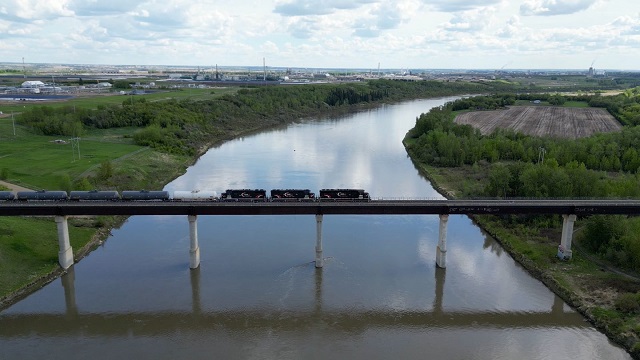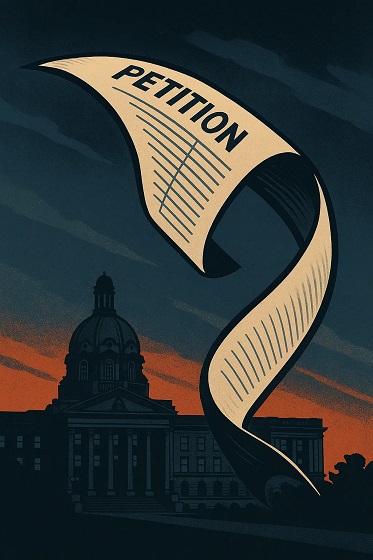Alberta
Alberta rail hub doubling in size to transport plastic from major new carbon-neutral plant

Haulage bridge at Cando Rail & Terminals’ Sturgeon Terminal in Alberta’s Industrial Heartland, near Edmonton. Photo courtesy Cando Rail & Terminals
From the Canadian Energy Centre
By Will Gibson
Cando Rail & Terminals to invest $200 million to support Dow’s Path2Zero petrochemical complex
A major rail hub in Alberta’s Industrial Heartland will double in size to support a new carbon-neutral plastic production facility, turning the terminal into the largest of its kind in the country.
Cando Rail & Terminals will invest $200 million at its Sturgeon Terminal after securing Dow Chemical as an anchor tenant for its expanded terminal, which will support the planned $8.9 billion Path2Zero petrochemical complex being built in the region northeast of Edmonton.
“Half of the terminal expansion will be dedicated to the Dow project and handle the products produced at the Path2Zero complex,” says Steve Bromley, Cando’s chief commercial officer.
By incorporating carbon capture and storage, the complex, which began construction this spring, is expected to be the world’s first to produce polyethylene with net zero scope 1 and 2 emissions.
The widely used plastic’s journey to global markets will begin by rail.
“Dow stores their polyethylene in covered railcars while waiting to sell it,” Bromley says.
“When buyers purchase it, we will build unit trains and those cars will go to the Port of Prince Rupert and eventually be shipped to their customers in Asia.”
A “unit train” is a single train where all the cars carry the same commodity to the same destination.
The expanded Cando terminal will have the capacity to prepare 12,000-foot unit trains – or trains that are more than three-and-a-half kilometers long.
Construction will start on the expansion in 2025 at a 320-acre site west of Cando’s existing terminal, which 20 industrial customers use to stage and store railcars as well as assemble unit trains.
Bromley, a former CP Rail executive who joined Cando in 2013, says the other half of the terminal’s capacity not used by the Dow facility will be sold to other major projects in the region.
The announcement is the latest in a series of investments for Cando to grow its operations in Alberta that will see the company spend more than $500 million by 2027.
The company, which is majority owned by the Alberta Investment Management Corporation previously spent $100 million to acquire a 1,700-railcar facility in Lethbridge along with $150 million to build its existing Sturgeon terminal.
Cando Rail’s existing Sturgeon Terminal near Edmonton, Alberta. Photo courtesy Cando Rail & Terminals
“Alberta is important to us – we have 300 active employees in this province and handle 900,000 railcars annually here,” Bromley says.
“But we are looking for opportunities across North America, both in Canada and the United States as well.”
Cando released the news of the Sturgeon Terminal expansion at the Alberta Industrial Heartland Association’s annual conference on Sept. 19.
“This is an investment in critical infrastructure that underpins additional growth in the region,” says Mark Plamondon, the association’s executive director.
The announcement came as the association marked its 25th anniversary at the event, which Plamondon saw as fitting.
“Dow’s Path2Zero came to the region because of the competitive advantages gained by clustering heavy industry. Competitive advantages are built from infrastructure that’s already here, such as the Alberta Carbon Trunk Line, which transports and stores carbon dioxide for industry,” he says.
“Having that level of integration can turn inputs into one operation into outputs for another. Competitive advantages for one become advantages for others. Cando’s investment will attract others just as Dow’s Path2Zero was a pull for additional investment.”
Alberta
Danielle Smith slams Skate Canada for stopping events in Alberta over ban on men in women’s sports

From LifeSiteNews
The Alberta premier has denounced Skate Canada as ‘disgraceful’ for refusing to host events in the province because of a ban on ‘transgender’ men in women’s sports.
Alberta Premier Danielle Smith has demanded an apology after Skate Canada refused to continue holding events in Alberta.
In a December 16 post on X, Smith denounced Skate Canada’s recent decision to stop holding competitions in Alberta due to a provincial law keeping gender-confused men from competing in women’s sports.
“Women and girls have the right to play competitive sports in a safe and fair environment against other biological females,” Smith declared. “This view is held by a vast majority of Albertans and Canadians. It is also common sense and common decency.”
Women and girls have the right to play competitive sports in a safe and fair environment against other biological females.
This view is held by a vast majority of Albertans and Canadians. It is also common sense and common decency.
Skate Canada‘s refusal to hold events in… pic.twitter.com/n4vbkTx6B0
— Danielle Smith (@ABDanielleSmith) December 16, 2025
“Skate Canada‘s refusal to hold events in Alberta because we choose to protect women and girls in sport is disgraceful,” she declared.
“We expect they will apologize and adjust their policies once they realize they are not only compromising the fairness and safety of their athletes, but are also offside with the international community, including the International Olympic Committee, which is moving in the same direction as Alberta,” Smith continued.
Earlier this week, Skate Canada announced their decision in a statement to CBC News, saying, “Following a careful assessment of Alberta’s Fairness and Safety in Sport Act, Skate Canada has determined that we are unable to host events in the province while maintaining our national standards for safe and inclusive sport.”
Under Alberta’s Fairness and Safety in Sport Act, passed last December, biological men who claim to be women are prevented from competing in women’s sports.
Notably, Skate Canada’s statement failed to address safety and fairness concerns for women who are forced to compete against stronger, and sometimes violent, male competitors who claim to be women.
Under their 2023 policy, Skate Canada states “skaters in domestic events sanctioned by Skate Canada who identify as trans are able to participate in the gender category in which they identify.”
While Skate Canada maintains that gender-confused men should compete against women, the International Olympic Committee is reportedly moving to ban gender-confused men from women’s Olympic sports.
The move comes after studies have repeatedly revealed what almost everyone already knew was true, namely that males have a considerable innate advantage over women in athletics.
Indeed, a recent study published in Sports Medicine found that a year of “transgender” hormone drugs results in “very modest changes” in the inherent strength advantages of men.
Additionally, male athletes competing in women’s sports are known to be violent, especially toward female athletes who oppose their dominance in women’s sports.
Last August, Albertan male powerlifter “Anne” Andres was suspended for six months after a slew of death threats and harassments against his female competitors.
In February, Andres ranted about why men should be able to compete in women’s competitions, calling for “the Ontario lifter” who opposes this, apparently referring to powerlifter April Hutchinson, to “die painfully.”
Interestingly, while Andres was suspended for six months for issuing death threats, Hutchinson was suspended for two years after publicly condemning him for stealing victories from women and then mocking his female competitors on social media. Her suspension was later reduced to a year.
Alberta
Alberta’s huge oil sands reserves dwarf U.S. shale

From the Canadian Energy Centre
By Will Gibson
Oil sands could maintain current production rates for more than 140 years
Investor interest in Canadian oil producers, primarily in the Alberta oil sands, has picked up, and not only because of expanded export capacity from the Trans Mountain pipeline.
Enverus Intelligence Research says the real draw — and a major factor behind oil sands equities outperforming U.S. peers by about 40 per cent since January 2024 — is the resource Trans Mountain helps unlock.
Alberta’s oil sands contain 167 billion barrels of reserves, nearly four times the volume in the United States.
Today’s oil sands operators hold more than twice the available high-quality resources compared to U.S. shale producers, Enverus reports.
“It’s a huge number — 167 billion barrels — when Alberta only produces about three million barrels a day right now,” said Mike Verney, executive vice-president at McDaniel & Associates, which earlier this year updated the province’s oil and gas reserves on behalf of the Alberta Energy Regulator.
Already fourth in the world, the assessment found Alberta’s oil reserves increased by seven billion barrels.
Verney said the rise in reserves despite record production is in part a result of improved processes and technology.
“Oil sands companies can produce for decades at the same economic threshold as they do today. That’s a great place to be,” said Michael Berger, a senior analyst with Enverus.
BMO Capital Markets estimates that Alberta’s oil sands reserves could maintain current production rates for more than 140 years.
The long-term picture looks different south of the border.
The U.S. Energy Information Administration projects that American production will peak before 2030 and enter a long period of decline.
Having a lasting stable source of supply is important as world oil demand is expected to remain strong for decades to come.
This is particularly true in Asia, the target market for oil exports off Canada’s West Coast.
The International Energy Agency (IEA) projects oil demand in the Asia-Pacific region will go from 35 million barrels per day in 2024 to 41 million barrels per day in 2050.
The growing appeal of Alberta oil in Asian markets shows up not only in expanded Trans Mountain shipments, but also in Canadian crude being “re-exported” from U.S. Gulf Coast terminals.
According to RBN Energy, Asian buyers – primarily in China – are now the main non-U.S. buyers from Trans Mountain, while India dominates purchases of re-exports from the U.S. Gulf Coast. .
BMO said the oil sands offers advantages both in steady supply and lower overall environmental impacts.
“Not only is the resulting stability ideally suited to backfill anticipated declines in world oil supply, but the long-term physical footprint may also be meaningfully lower given large-scale concentrated emissions, high water recycling rates and low well declines,” BMO analysts said.
-

 Digital ID2 days ago
Digital ID2 days agoCanada releases new digital ID app for personal documents despite privacy concerns
-

 Energy2 days ago
Energy2 days agoCanada’s sudden rediscovery of energy ambition has been greeted with a familiar charge: hypocrisy
-

 Daily Caller23 hours ago
Daily Caller23 hours agoParis Climate Deal Now Decade-Old Disaster
-

 Bruce Dowbiggin2 days ago
Bruce Dowbiggin2 days agoNFL Ice Bowls Turn Down The Thermostat on Climate Change Hysteria
-

 Business13 hours ago
Business13 hours agoOttawa Pretends To Pivot But Keeps Spending Like Trudeau
-

 armed forces1 day ago
armed forces1 day agoOttawa’s Newly Released Defence Plan Crosses a Dangerous Line
-

 Energy12 hours ago
Energy12 hours agoLiberals Twisted Themselves Into Pretzels Over Their Own Pipeline MOU
-

 Censorship Industrial Complex10 hours ago
Censorship Industrial Complex10 hours agoHow Wikipedia Got Captured: Leftist Editors & Foreign Influence On Internet’s Biggest Source of Info











